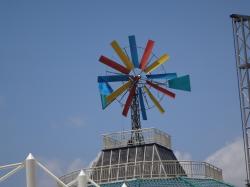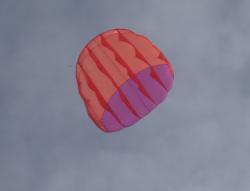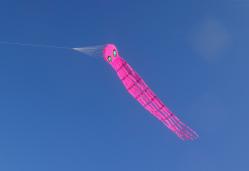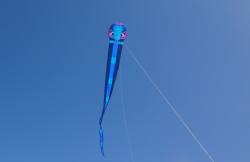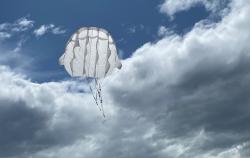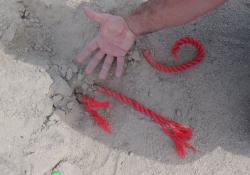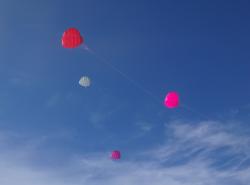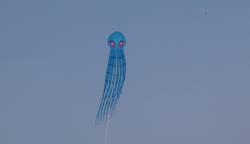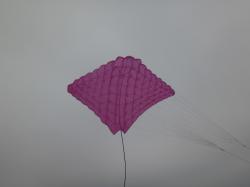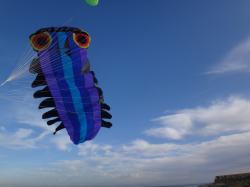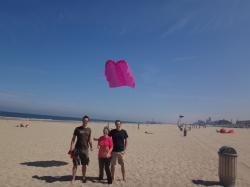SINGLE SKIN SINGLE LINE KITES UPDATE
Published: 01 Jan 2024
SINGLE SKIN SINGLE LINE KITES UPDATEPeter Lynn, April 2023Kite OriginsThe first kites were most likely leaves, that, quite by chance, fly as kites when a line is attached to them in the right place. Their discovery could easily have happened when such leaves were used to float fishing lines out to where the fish were- most likely in Indonesia (where Lokoloko leaves are still used for kite fishing), and possibly more than 10,000 years ago. Indonesian Lokoloko leaf kites in Tokyo kite m...
Click to Continue Reading
SSSL Nomenclature
Published: 01 Mar 2023
SSSL: Single Skin, Single Line kite. Lift: Aerodynamic lift forces that enable kites to fly. Drag: Aerodynamic drag forces that pull a kite in the wind direction Lift/drag ratio (L/D); Aerodynamic efficiency; tangent of the flying line angle. Centre of gravity (C of G): Where the sum of a kite's weight forces act. Centre of lift (C of L): Where the resultant of lift forces act. Centre of pressure (C of P): Where the resultant of lift and drag forces act Recover...
Click to Continue Reading
SSSL 1Skin type kites
Published: 27 Feb 2022
History: The 1Skin Saga; late 2014 to mid 2018.Using the uniform camber principle (no trailing edge pull down), an SSSL with semi circular shape and 7 keels was soon flying- followed by 5 cell 1Skins and 4 cell Singers.While retaining the same leading-edge construction as earlier designs, the use of chordwise camber instead of trailing edge hook-down provided a much wider wind range. Their excellent lift to drag ratio (L/D) gave them a 60degree plus flying angle and the usual pull/size advantage...
Click to Continue Reading
SSSL Ray
Published: 24 Feb 2022
History:Ray 1 June 2015, purple, AR 1.4 uncontrollable diving over. Used rope tail. Held shape OK, but would not fly for even 10 seconds.Ray 2, Pink, Jan 2020, AR 1, with cut back rear. With ribbon tails, did fly, but exhibited uncontrollable falling off wing tip collapse except sometimes in strong winds.Ray 2 Blue/blue/black, Feb 2020, AR 1.0 with cut back rear. Flies relatively well but with falling off/tip collapse in lighter winds and weaving instability in strong win...
Click to Continue Reading
Single Skin Pilot (SSP)
Published: 01 Feb 2022
Goal is a SS pilot kite that is reliable and steady in a wide wind rangeThis series started with 101 pink ¾ Serpent head (Jan 2019), and they initially all had curved leading edges.From SSP 8 , orange/pink, Nov '21, side keels were increased in depth to provide lateral area and reduce the requirement for tails. It was soon found that this area needed to be further forward than a semi-circular LE would permit.The LE then became straight with tight radius corners and initial problems wi...
Click to Continue Reading
SS Serpent
Published: 01 Feb 2022
Serpents. Tails effects on stability:102 pink ¾ serpent head, built February 2019: Tests:1. With original rear keels dived over uncontrollably - wouldn't stay up even for seconds.2. With keels removed, ribbon tails attached at centre line, flew stably to 30km/hr or so, then WI.1. With full width tail was weaving unstable and fell off to side when wind dropped.2. With full width tail attached by cords leaving 300mm gap, no improvement3. With full width tail attached with bungies, no improve...
Click to Continue Reading
Octopus
Published: 30 Jan 2022
Wakanui Kite Day, 30 Jan '22Quite strong easterly later in day.30m Pink Octo flew very well on quite a short line all day, was just beginning to show some weaving by pull down time.No tail tangles at all.
Observations and Questions 2022
Published: 01 Jan 2022
1. First law of single line kites: The C of G must be below the C of P. This creates a correcting moment that points the kite upwards. Certain. 2. "Blink" stability is useful for some styles of single skin single line kites. 3. For SSSLs, chordwise buckling is more of a problem than spanwise buckling: space chordwise bridles closer. 4. Chordwise buckling is a major cause of hanging off, falling off and diving over (the 3 nasties). 5. ...
Click to Continue Reading
SSSL Sled
Published: 30 Dec 2021
From 2014, various attempts were made at developing SSSLs with no bridles to the body, all bridles being to the sides. Some are pure sleds (one an Arc sled with just 4 bridles), but most have bridle supported leading edges.An inherent problem is that side keels of the constant depth required to support the centre tend to cause a tapered or toe in shape (wider at the TE) which 'hand claps' in stronger winds, and when the keel depth is reduced towards the rear to address this, the dispositio...
Click to Continue Reading
SSSL Curved Leading Edge Pilot (CLE Pilot)
Published: 23 Dec 2021
History to 2021:SSSL 101 pink ¾ Serpent head made in February 2019 showed characteristics that made it a promising start point for a SSSL pilot kite that would fly reliably in strong wind and not be subject to the Diving Over problem that plagued 1Skins in strong and gusty winds.101 has 56 bridles and complex cording `which makes it somewhat impractical in small sizes, so the direction of development has been towards simplification while retaining strong wind reliability.Initially the direction ...
Click to Continue Reading
SSSL Development from, 4 April'14 (Chongqing) to 4 March '17
Published: 01 Apr 2018
SSSL Development from, 4 April'14 (Chongqing) to 4 March '17 .Reprise:SSSL 3 was reasonably promising but none of the attempts from then until SSSL13 were very hopeful (some did fly OK in smooth mid range wind). SSSL4 to SSSL12 were all pure sleds of one form or another (no central keel).Some observations so far:1. Using a lower leading edge seem to enable lower A of A without LE collapse- but SSSL19 green?2. It appears that pure sleds become too wide at rear, tapering in LE then causes co...
Click to Continue Reading
SSSL update from Feb 19 to May 1 '17
Published: 31 Dec 2017
Octopus;There was no change to shape or bridling during this period (Feb 19 to May 4 '17). Octopus's remain the best flying SSSL's - better in some ways than even the latest 1Skins in their ability to deal with strong winds without sometimes diving off to one side unrecoverably. Light wind flying is also impressive, but the tail links are a pain the way they catch on things - and in their propensity to tangle.20m blue (the original one that was really flying well by Kelantan '15 and ...
Click to Continue Reading
After Mongolia Guangdong, Weifang, Shenzhen. 20 Oct to 1 Nov 2015.
Published: 30 Jul 2015
After Mongolia Guangdong, Weifang, Shenzhen. 20 Oct to 1 Nov 2015.Octopus and Serpent: The Serpent currently has much more curve-down on each side; more sled like than the Octopus (Blue ex Kaixuan). The Octopus also has less camber in the mid-top body area. Flown alone, the Octopus has more inclination to falling-off to one side in light conditions- making launching in light winds difficult. At none of these events, did it show any tail tangling tendency- and quite strong winds at Shenzhen, almo...
Click to Continue Reading
SSSL Boomers
Published: 04 Apr 2014
SSSL Development from Chongqing, from 4 April'14Reprise:SSSL 3 was reasonably promising but none of the attempts from then until SSSL13 were very hopeful (some did fly OK in smooth mid range wind). SSSL4 to SSSL12 were all pure sleds of one form or another (no central keel).Some observations so far:1. Using a lower leading edge seem to enable lower A of A without LE collapse- but SSSL19 green?2. It appears that pure sleds become too wide at rear, tapering in LE then causes collapse.3. Or, ...
Click to Continue Reading



